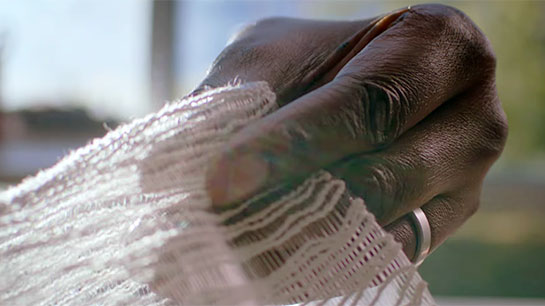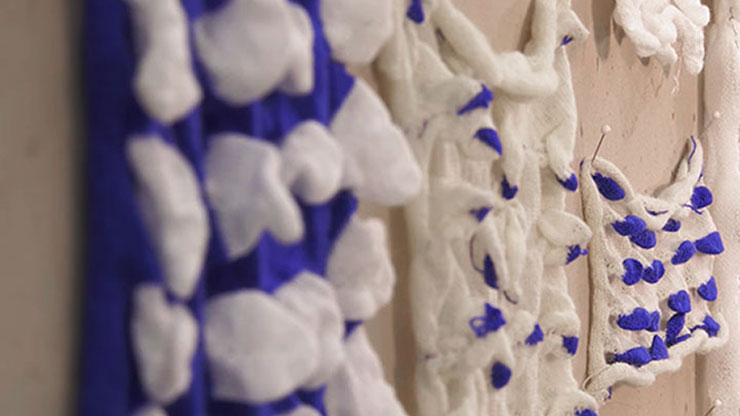Felecia Davis, assistant professor of architecture at the Stuckeman Center for Design and Computation, has been studying the aesthetics and tactility of design for years. Now, she’s studying the productivity of it.
Using emerging technologies, like photovoltaic stands, she’s imagining how fabric can do more. From a self-powering emergency shelter, to infant onesies that report biometrics, fabric that’s smarter can improve lives the world over. Davis has made a career of working with other disciplines to rethink how everyday materials and structures can contribute to happier, healthier lives—and she shows no signs of slowing down.
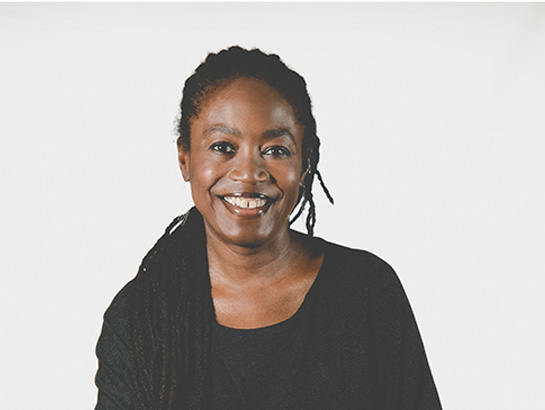
Felecia Davis, associate professor, Stuckeman School, College of Arts and Architecture
Impact
Because everyone should have access to energy
“Textiles are everywhere, so if you have a fiber that can be weaved into just about anything, efficiency takes on another meaning because you have this growth of scale. Solar fibers can be integrated into clothing, car upholstery, convertible tops, furniture, curtains—there are all of these uses that I saw for them.”
Our Clothes Can Light Our Way
Davis has drawn on Penn State’s vast resources and expertise in fields ranging from energy and mineral engineering to electrical engineering and landscape architecture to form a collaborative, interdisciplinary team focused on developing a solar tent. The goal of the project is to develop a tent that is both functional in providing shelter but that can also capture enough energy through its solar fibers to power a cellphone.
Davis said the team’s solar tent will serve as a gateway to utilizing solar fabrics in other contexts.
“It’s not just a tent to us,” she said. “It’s really a way of understanding how we can get this fiber into a fabric so it can be worn, put into furnishings or used as shelter.”
The fiber, which was discovered—almost by accident—by John Badding, professor of chemistry, physics, and material sciences and engineering at Penn State, is razor thin, much like a strand of hair, but it can collect energy from all sides, and its flexibility makes it conducive to being weaved into fabric. The fiber’s utility as a strand-based solar cell was not lost on Davis, and it fit perfectly in with her interest in computational textiles—fabrics that respond to commands through computer programming, electronics, and sensors.
The researchers are now looking at how they can get the most energy out of the fabric while also understanding how machines can incorporate the fibers in such a way that solar fabrics might be produced in an industrial setting in the future.
Re-Inventing Industries
The industrial component is especially important in Pennsylvania, where communities are seeking to re-invent themselves after a decades-long decline in manufacturing jobs. Davis said computational textiles offer the opportunity to find solutions to problems that will ultimately make life better, and she believes Pennsylvania can play an important role as smart textiles evolve.
“Pennsylvania has a strong textile manufacturing base, and our state can be part of this transformation,” said Davis. “Penn State has partnered with Drexel, and Drexel will be a manufacturing center. We share industrial machines with them to produce the work here. So Pennsylvania can be a hub of manufacturing and jobs, and these are jobs that are a combination of tech and traditional. It’s a way of revitalizing a traditional industry and bringing it into the 21st century.”
While solar fabrics show tremendous promise as a source of capturing and utilizing energy, smart fabrics in general have a wide range of potential real-world uses. For example, Davis pointed to applications where computational textiles embedded with electronics and sensors can help to monitor an infant’s breathing, map an individual’s walking pattern to better understand their health, or track a patient’s vitals from the comfort of home rather than a hospital bed.
As an architect, Davis is especially in tune to the conceivable impact that computational textiles can have on the future of hospitals and the evolution of patient care. “If you can monitor a patient from home, they don’t have to be in a hospital,” Davis said.
“If patients are able to stay at home, then you don’t need such a big hospital, and your hospital can be conceived of in a completely different way.”
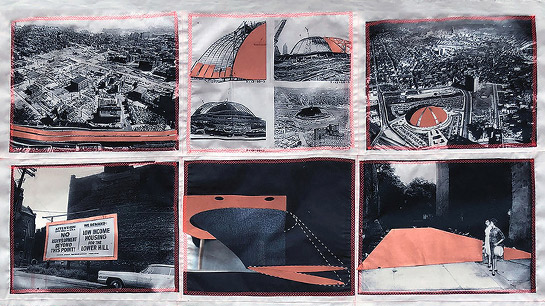
Davis is one of ten architects, designers, and artists whose work will be featured in a Spring 2021 Museum of Modern Art (MoMA) exhibition that examines contemporary architecture in the context of how systemic racism has fostered violent histories of discrimination and injustice in the United States. Learn more about Davis’ work in this Penn State News article (February 10, 2021).
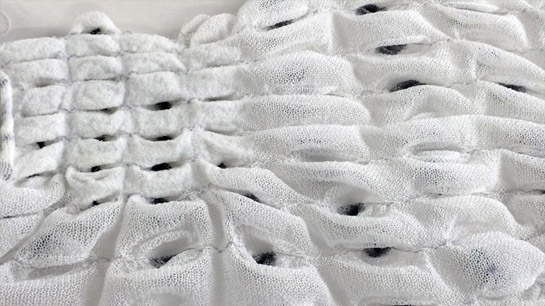
As part of the Women in Science series, WPSU profiled Davis in a video highlighting her research at the intersection of art and science. WPSU also held a video interview with Davis where she discusses smart fabrics and her journey into the research field.

The Stuckeman Center for Design Computing is a multidisciplinary community of researchers exploring computation as a subject of creative and scholarly inquiry in design across scales and modes of engagement: from the territorial to the micro, from the theoretical to the material, and from the applied to the speculative and critical. The center’s projects variously engage architectural robotics, simulation and visualization, game development, geographic information systems, sustainable development, and digital fabrication, as well as historical and theoretical aspects of computation in design.



